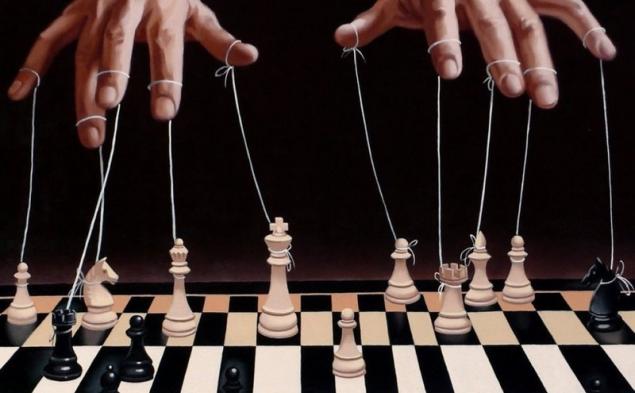475
5 ways to recognize manipulation at work
How to recognize the psychological impact on the work and in your personal life? What types of manipulation and how they can be used in the management of people? "Theory and Practice" published the main points of Constantine Bagrationi lecture - lecturer of the Faculty of Management of HSE
. Social commitments
Social commitment - the easiest kind of manipulations, which are stacked in three words: "made a promise - Accomplish." For example, on the principle management technologies are built in the company Amway: every seller fills out an individual plan, where one of the points is the amount of sales. Thus, the employee would like to implement promises to the paragraph in that whatever the cost, which greatly affects his perception of the work.

Companies often use a universal scheme, first create attractive image of the employee as the person responsible, consistent, keep our promises, and then he delegated certain tasks. Because everything is happening in public, a person becomes ashamed to admit that he is something can not be done (otherwise destroy the image), and it continues to fill up jobs.
Critical chain method Use can be and how a person comes to workflow. If an employee breaks the task into parts and performs slowly, which means that it has a target type of thinking, and if he lays up the latter, a process. When a team most of the staff is a process-type thinking, they should be encouraged to work, in this case, the head of the rational use of critical chain method (MCC).
We consider it more in detail. According to Parkinson's Law, the work aims to take all the time allotted to it. For example, the traditional approach the task A is usually solved in 8 days, and in the - in 12 days (self-completion of the designated days, up to 90%), whereas in the MCC on each task is given half the time (respectively, confidence in the timely implementation of It is only 50%). Then you divide the tasks for critical and non-critical: if the work depends on the work in A, then there is no point in doing the job faster and earlier work A (critical). And in order to minimize the risks to the end of the network schedule is included project buffer consisting of reserve time saved at the accelerated work on the A and B (this method is described by Eliyahu Goldratt in the business novel "Critical Chain»).
Solution
conflict When you create a new working group, it goes through several stages: 1) familiarity group members to each other; 2) questioned the status of the leader of the group; 3) definition of the informal leader, perform each of its tasks; 4) the operation of the group as a coherent system, and 5) the dissolution of the group or the replacement of individual participants. Of course, the conflict can not be avoided, but in order to reduce their number, head of the need to present the attractive image of the future of the project, to which members of the group could match their goals.
And sometimes, especially the method of conflict management. People are divided into three types: "rabbits" (in a conflict situation, they can not do their job), "Lions" (mobilizing their forces to do the job) and "oxen" (they do not care what's going on, they just do what they must). When a team is dominated by "oxen" and "lions", is to create an aggressive-depressive environment for productive work.
Pressure
authorities Perhaps the most powerful manipulation - "public opinion". Take, for example, a jar with donations if it is initially empty, no one will put a penny back. But when there is already a few coins, the effect will be the opposite. The need to be "like everyone else" - one of the basic in man ( "all the time stealing stationery items at work, and I can»)
. In 1971, a Soviet documentary director Felix Sobolev made a movie, "I and others", where he showed a series of experiments on suggestibility. It clearly shows how powerful this kind of manipulation as "authoritative opinion". In modern Russia in this role are the media. Speaking of authoritative opinions, not to mention the casual attribution. The phenomenon is what we provide information about a person, for example, that it is an alcoholic. And when we see this man dressed sloppily, then we think: "Well, of course, because he is an alcoholic, how he has to look." In the context of information scarcity think up your own image.
To become an "authority" it is important to remember that the first impression is remembered best. American political scientist Harold Lasswell has developed a communicative model that helps to achieve a good first impression. First we need to define the image of a speaker ( "expert", "your guy", etc.). Then build it (what, how and to whom you want to communicate). Everyone wants to be something better than the other - so do not deprive him of it. If you are managing a team representing people with each other in a good light, "A - a specialist in risk, - on the budget." It will raise the team spirit. In addition, you can use symbols of power: the title (title), clothing, luxury accessories. Once you fix for a certain image, a halo effect works: your every action will be perceived by others as confirmation of your image
. Urgency and unequal exchange
Not only at work, but also in everyday life, we are faced with the manipulation. One of them is based on unequal exchange, for example, filling the employee, without asking you, providing small services - car glass wipes, inserts a hose into the tank, thus forcing you to give him money. Another known manipulation - "pressure of time". "The decision should be taken now, and the train will leave" - that all known formulation.
. Social commitments
Social commitment - the easiest kind of manipulations, which are stacked in three words: "made a promise - Accomplish." For example, on the principle management technologies are built in the company Amway: every seller fills out an individual plan, where one of the points is the amount of sales. Thus, the employee would like to implement promises to the paragraph in that whatever the cost, which greatly affects his perception of the work.

Companies often use a universal scheme, first create attractive image of the employee as the person responsible, consistent, keep our promises, and then he delegated certain tasks. Because everything is happening in public, a person becomes ashamed to admit that he is something can not be done (otherwise destroy the image), and it continues to fill up jobs.
Critical chain method Use can be and how a person comes to workflow. If an employee breaks the task into parts and performs slowly, which means that it has a target type of thinking, and if he lays up the latter, a process. When a team most of the staff is a process-type thinking, they should be encouraged to work, in this case, the head of the rational use of critical chain method (MCC).
We consider it more in detail. According to Parkinson's Law, the work aims to take all the time allotted to it. For example, the traditional approach the task A is usually solved in 8 days, and in the - in 12 days (self-completion of the designated days, up to 90%), whereas in the MCC on each task is given half the time (respectively, confidence in the timely implementation of It is only 50%). Then you divide the tasks for critical and non-critical: if the work depends on the work in A, then there is no point in doing the job faster and earlier work A (critical). And in order to minimize the risks to the end of the network schedule is included project buffer consisting of reserve time saved at the accelerated work on the A and B (this method is described by Eliyahu Goldratt in the business novel "Critical Chain»).
Solution
conflict When you create a new working group, it goes through several stages: 1) familiarity group members to each other; 2) questioned the status of the leader of the group; 3) definition of the informal leader, perform each of its tasks; 4) the operation of the group as a coherent system, and 5) the dissolution of the group or the replacement of individual participants. Of course, the conflict can not be avoided, but in order to reduce their number, head of the need to present the attractive image of the future of the project, to which members of the group could match their goals.
And sometimes, especially the method of conflict management. People are divided into three types: "rabbits" (in a conflict situation, they can not do their job), "Lions" (mobilizing their forces to do the job) and "oxen" (they do not care what's going on, they just do what they must). When a team is dominated by "oxen" and "lions", is to create an aggressive-depressive environment for productive work.
Pressure
authorities Perhaps the most powerful manipulation - "public opinion". Take, for example, a jar with donations if it is initially empty, no one will put a penny back. But when there is already a few coins, the effect will be the opposite. The need to be "like everyone else" - one of the basic in man ( "all the time stealing stationery items at work, and I can»)
. In 1971, a Soviet documentary director Felix Sobolev made a movie, "I and others", where he showed a series of experiments on suggestibility. It clearly shows how powerful this kind of manipulation as "authoritative opinion". In modern Russia in this role are the media. Speaking of authoritative opinions, not to mention the casual attribution. The phenomenon is what we provide information about a person, for example, that it is an alcoholic. And when we see this man dressed sloppily, then we think: "Well, of course, because he is an alcoholic, how he has to look." In the context of information scarcity think up your own image.
To become an "authority" it is important to remember that the first impression is remembered best. American political scientist Harold Lasswell has developed a communicative model that helps to achieve a good first impression. First we need to define the image of a speaker ( "expert", "your guy", etc.). Then build it (what, how and to whom you want to communicate). Everyone wants to be something better than the other - so do not deprive him of it. If you are managing a team representing people with each other in a good light, "A - a specialist in risk, - on the budget." It will raise the team spirit. In addition, you can use symbols of power: the title (title), clothing, luxury accessories. Once you fix for a certain image, a halo effect works: your every action will be perceived by others as confirmation of your image
. Urgency and unequal exchange
Not only at work, but also in everyday life, we are faced with the manipulation. One of them is based on unequal exchange, for example, filling the employee, without asking you, providing small services - car glass wipes, inserts a hose into the tank, thus forcing you to give him money. Another known manipulation - "pressure of time". "The decision should be taken now, and the train will leave" - that all known formulation.
























